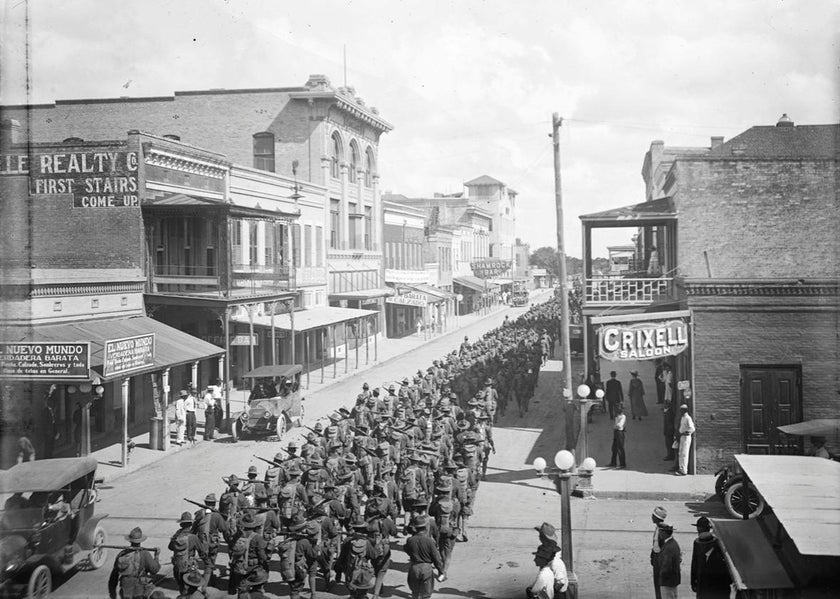Slate by Rebecca Onion May 05, 2016
Texas Rangers and civilian vigilantes killed thousands of Mexican-Americans in a campaign of terror. A century later, will the state finally acknowledge the bloodshed?

On June 18, 1916, U.S. President Woodrow Wilson ordered 110,000 National Guardsmen from state militias to the border
for patrol duty. Above, troops in Brownsville, Texas.
A hundred years ago, in the Texas counties along the U.S.–Mexico border, a decade-long flurry of extralegal killings perpetrated by Texas Rangers, local law enforcement, and civilian vigilantes took the lives of
thousands of residents of the United States who were of Mexican descent, and pushed many more across the border into Mexico. This record of death and intimidation, which irrevocably shaped life in those border counties, has not been commonly taught in the state’s mainstream school curricula or otherwise recognized in official state histories. Mexican-American communities, however, have preserved the memory of the violence in family archives, songs, and stories. “To many Mexicans, contemporary violence between Anglos and Mexicans can never be divorced from the bloody history of the Borderlands,”
write William D. Carrigan and Clive Webb in their history of lynchings of Mexican-Americans. “They remember, even if the rest of the country does not.”
Belatedly, tentatively, Texas has begun to reckon with this bloody history. As election-year rhetoric around the border and Mexican immigration has reached new levels of
xenophobia and racism, the state—goaded by a group of historians calling themselves
Refusing to Forget—has taken steps toward commemoration of the period called “
La Matanza” (“The Killing”), with
an exhibit at the Bob Bullock Texas State History Museum and three historical markers soon to be unveiled. For a state that has long refused to come to terms with those years—sealing transcripts of a Congressional investigation into the killings and waxing nostalgic about the Texas Rangers despite their involvement—it’s something like progress, even if the legacy of this violence will require far more than exhibits to expiate.
The deaths that occurred between 1910 and 1920 are part of a longer history of lynching of Mexicans and Mexican-Americans in the United States—itself little-discussed in comparison with the parallel history of violence against black Americans. Carrigan and Webb identify waves of violence against Americans of Mexican descent in the 1850s (when Mexicans were forcibly expelled from many mining camps in California), the 1870s (when Mexicans and Americans both took to
raiding farms and ranches across their respective borders), and the 1910s. While a mob’s stated reason for lynching black victims tended to be an accusation of sexual violence, for Mexicans in the United States, the reason given was often retaliation for murder or a crime against property: robbery, or what was sometimes called “banditry.”
Property—in the form of land—was the underlying cause of the Texas border violence that took place in the second decade of the 20th century. At the turn of the 20th century, an epic, often illegal, transfer of land began, moving ownership from Tejanos living in the border counties of Texas to newly arrived Anglo farmers and ranchers. (Because the people living through this history did not use the term “Mexican-American” to describe themselves, I’m following the lead of the Refusing to Forget historians, and using the terms “Texas-Mexicans” or “Tejanos” to describe Texas residents of Mexican descent.) The advent of the railroad, which reached the border city of Brownsville in 1904, made Anglo expansion onto historically Mexican land possible, seriously shifting the balance of power in the land along the Rio Grande.
This area had fallen within the borders of the United States since the middle of the 19th century, when the
Treaty of Guadalupe Hidalgo ended the Mexican-American War and made the river the new boundary between the two countries. But it had remained culturally Mexican, with many Mexican residents staying on the ranches where they had been living—which were now, legally, located in Texas. Between the signing of the treaty and the advent of the railroad, the area was predominately Mexican, with a small number of Anglo settlers mixing into the culture, intermarrying with Tejano neighbors and learning to speak Spanish. As historian John Moran Gonzalez put it to me: “You paid your taxes in dollars, but you paid for your groceries in pesos. English was the language of government but everybody spoke Spanish.” The Border Patrol wasn’t founded until 1924; in the meantime, people went back and forth across the river easily.
More:
https://slate.com/news-and-politics/2016/05/texas-finally-begins-to-grapple-with-its-ugly-history-of-border-violence-against-mexican-americans.html